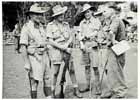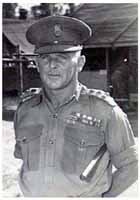In the First World War, Arnold Potts rose from Lance Corporal to Brigadier, and fought at Gallipoli and in France. By 1918, he was a Captain and had been awarded the Military Cross (MC). In the inter-war years, Arnold Potts was a farmer in West Australia, but was active in the formation of a militia unit just before the Second World War began. In 1940, at the age of 44, he enlisted in the Second Australian Imperial Force (2nd AIF). Potts was accepted as a Major, in command of Headquarter Company, 2/16th Australian Infantry Battalion.
As part of 21st Brigade, the 2/16th fought the Vichy French in the Allied invasion of Syria in 1941. Potts was awarded the Distinguished Service Order (DSO), promoted Lieutenant Colonel and appointed to command the 2/16th. When the war spread to the Pacific, and Potts’ battalion returned to Australia in 1942, he was in command of the brigade.
21 Brigade comprised the Victorian 2/14th Battalion, the West Australian 2/16th and the South Australian 2/27th, and, with the 18th and 25th Brigades, made up the 7th Australian Division, commanded by Major General Arthur Allen.
After the Japanese landed at Gona on 21 July 1942, and began to advance on Port Moresby, only one partly trained Australian militia battalion could be deployed, on foot, to resist the advance, and the situation on the Kokoda Track became serious. The loss of Port Moresby, and so all Papua New Guinea, would be disastrous for the Allies. Potts’s brigade began to move to Papua New Guinea in early August. They were experienced in battle but untrained in jungle warfare and not properly equipped for such a campaign. As soon as they arrived, Potts’ battalions began the exhausting march up the Kokoda Track to meet the advancing units of Major-General Horii Tomitaro’s South Seas Force.
By 26 August, Potts’s men were in action against attacking Japanese battalions at Isurava. The Australians had only personal weapons, no heavy support weapons, no artillery, and were not properly equipped. The Japanese enjoyed all those advantages.
Potts understood that he could hold his brigade in place and fight to the end, so making a sacrifice in the mountains of Papua New Guinea, or he could manoeuvre his force in a fighting retreat and force Horii’s units to deploy and attack, reorganise, advance, deploy and attack, reorganise and advance, in a series of actions that would inflict on Horii loss of the one item which could not be replaced – time. Loss of time for Horii would permit more Australian units to arrive and so permit the defence of Port Moresby to be improved. Fighting in the mountains placed an enormous burden on the attacking force, and the further Horii advanced, the greater became his problems of supply, reinforcement and evacuation of casualties.
Potts’s task was not made easier by a lack of understanding at his own headquarters. Potts was ordered to report to Major General Allen, and set off to the rear on 10 September. He was replaced by Brigadier Selwyn Porter. The Japanese were halted at Imita Ridge and the Australian advance began on 23 September, and ended on 22 January 1943 with the total destruction of the Japanese force in the Buna–Gona area on the north coast. After reporting in detail on the conditions under which the fighting was conducted, Potts remained in New Guinea in command of 21st Brigade until October, when he was sent to a command at Darwin.
Brigadier Arnold Potts DSO MC MID made a difference to the campaign in Papua New Guinea in 1942 because he realised the advancing Japanese could be in Port Moresby in a few days unless his formation inflicted upon them loss of the time needed for the Australian defences to be improved. His decision to make a fighting retreat was crucial to the eventual Australian success.
Recommended reading
Edgar, Bill "Warrior of Kokoda", Allen & Unwin, Australia, 1999.
McAulay, Lex "Blood & Iron", Hutchinson Australia, 1991.
Kokoda (part 1):
 Overview text
Overview text Longer text
Longer text  Images
Images  Readings
Readings  Albert Moore
Albert Moore  Arnold Potts
Arnold Potts  Harvey Blundell
Harvey Blundell  Kiki Baiyane
Kiki Baiyane  Map
MapClick images to enlarge.

AWM 026716

AWM 040711

AWM 099103

AWM 091184
